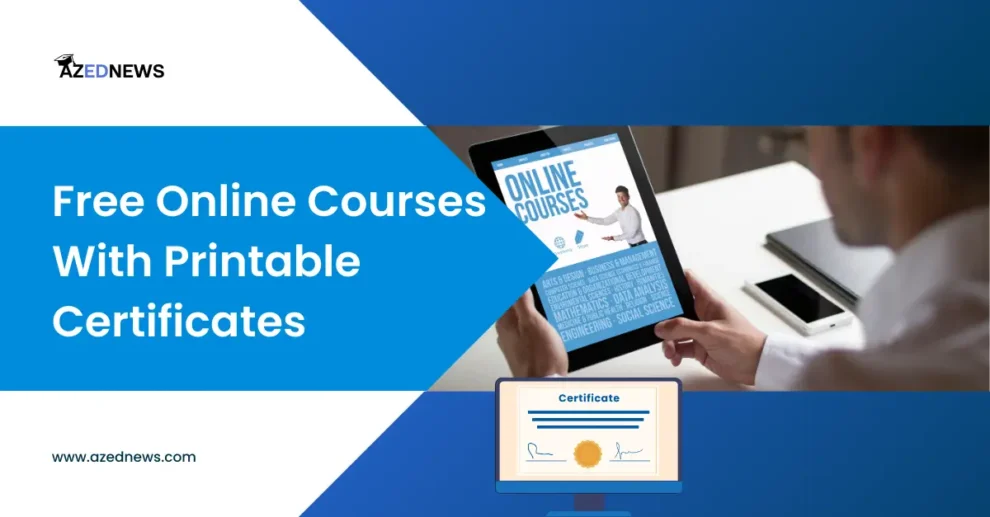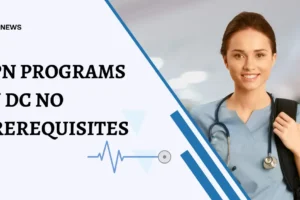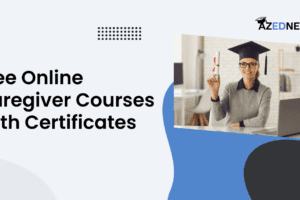There are various free online courses with printable certificates available for students. The best thing about online courses is that they can be completed at any time and students can enroll from anywhere.
Table of Contents
In this blog, you will find a list of free online courses with printable certificates that are committed to open and accessible learning for ambitious candidates worldwide. These courses are available with no geographical restrictions or entry requirements.
The free online courses with certificates fit the bill whether you’re trying to establish your own business, better your employment chances, add flair to your resume or just take a chance on a novel subject.
Key Takeaways:
- Free online courses with printable certificates are a major hit among students since they allow people to gain skills easily.
- There are various benefits of free online courses such as students can study at their pace and time among many others.
- Some free online courses with printable certificates include understanding dementia conducted by the University of Tasmania.
- Spatial analysis is another popular free course often chosen by people since it helps in expanding career opportunities.
What are the benefits of free online courses?
Companies or colleges offering free online courses work very hard to provide each applicant with the same superior learning environment and unwavering support throughout.
Enrolling in these special, no-cost short courses entitles students to the following standard benefits:
- Students can study at their own pace and time
- There are no time restrictions, no exams, and no deadlines
- All the required materials are provided as per standard requirements
- Full tutor support is provided from start to end
- The enrolment is open for 365 days
- Students can study from anywhere in the world with a proper internet connection.
Top Free Online Courses With Printable Certificates:
1. Understanding dementia:
- Conducted by: University of Tasmania
The Wicking Dementia Research and Education Centre, located in the University of Tasmania’s College of Health and Medicine, created the Understanding Dementia MOOC (Massive Open Online Course).
Anyone interested in dementia can access this internationally acclaimed online course, which is simple to use, free, and available to all. You will pick up knowledge to enhance the quality of life for individuals who are living with dementia from the world’s foremost authorities in dementia research and teaching.
The purpose of Understanding Dementia is to make it pleasant and approachable to individuals from a variety of backgrounds, such as:
- Individuals with dementia, as well as their friends, family, and caregivers
- Support personnel in residential and community facilities
- Medical practitioners
- Policymakers in health
- People who are generally interested in dementia
Course outline:
- The Brain
Gives an overview of the basic architecture and function of the nervous system before going over dementia-causing disorders, ongoing research on dementia, and potential future possibilities.
- The Diseases
Examines the distinctions between dementia and normal aging, risk factors, dementia symptoms, difficulties with diagnosis, and medical treatment.
- The individual
Discusses behavioral and psychological symptoms, living with dementia, palliation, progression and staging, and nonpharmacological therapy.
2. Going places with Spatial analysis:
- Conducted by: Esri via independent
Those who have some experience with data analysis and would like to learn more about the unique features of spatial data analysis course should sign up for this Massive Open Online Course (MOOC). Spatial analysis employs geography as a focal point to help interpret data more deeply.
Organizations throughout the world are in great demand for people with expertise in spatial analysis. The whole analytical feature set of Esri’s cloud-based GIS platform, ArcGIS Online, is yours for free. Though not required, prior knowledge of GIS software is advantageous for tech-savvy problem solvers.
Course outline:
- Using Spatial Analysis to Go Places
After taking into account the unique qualities and importance of spatial data and analysis, launch ArcGIS Online.
- Recognizing and Comparing Locations
Watch quick courses on basic subjects like as projection, scale of analysis, descriptive statistics, and queries. The greatest places for new mixed-use development can be shown on a map created by querying a layer and adding attributes.
- Assessing the Relationships Among Places
Discover the adjustable areaal unit problem, vector overlay, and data normalization for choropleth mapping. To monitor water quality, use ArcGIS Online to study watersheds and compile a list of all the lamps in a city’s maintenance assessment area.
- Identifying the Ideal Places and Routes
Talk about cost routes, site suitability, topology, and other important ideas. ArcGIS Online may be used to identify ideal locations for cougar habitat and appropriate places for supermarket delivery centers.
- Finding and Measuring Patterns
Spatial autocorrelation, density surfaces, and spatiotemporal analysis are among the subjects covered in lectures. Analyze hot spots and densities to see trends in property and person crimes.
- Creating Forecasts
Study surface analysis, interpolation, regression, and spatial interaction. Map the areas at risk of persistently low air quality by interpolating sample points using ArcGIS Online.
3. Bacterial Genomes II: Accessing and Analysing Microbial Genome Data Using Artemis
- Conducted by: Future Learn
Significant advances in medicine are facilitated by the application of increasingly potent computing to genomics. In the bacterial genomes II: Accessing and Analysing Microbial Genome Data Using Artemic will learn the fundamentals of comparative genomics and microbial bioinformatics analysis in this course.
You will learn how to examine entire bacterial genomes using Artemis, a free genome browser, and you will examine the genomic characteristics of pathogens by examining bacterial genes and proteins. You will be able to use genomic data to broaden your understanding of microbial genomes at the end of this course.
Course outline:
- Reference genomes and introduction to Artemis
- Genome annotation, GC (guanine-cytosine) content, and data access
- Consolidation and Peer Review Project
4. Full stack open:
- Conducted by: University of Helsinki
You will learn about contemporary JavaScript-based web development in this course. The primary focus is on using Node.js to develop REST APIs for single-page applications built using ReactJS.
Course outline:
- The basics of online applications
We will acquaint ourselves with the course’s practicalities in this section. Subsequently, we will review the fundamentals of web development and discuss the developments in online application development over the past couple decades.
- Overview of React
The React-library, which we will be utilizing to write the code that runs in the browser, will be introduced to us in this section. We will also examine a few JavaScript concepts that are critical to comprehending React.
- Speaking with the server
Initially, we will examine how to display a collection of data, such as a list of names, on the screen. Next, we will examine how a user can utilize HTML forms to submit data to a React application. After that, we turn our attention to examining how browser-based JavaScript code can retrieve and manage data from a remote backend server. Finally, we will quickly go over a few basic methods for incorporating CSS styles into our React apps.
- Setting up a server using Express and NodeJS
In this section, we start concentrating on the backend, or the server side of the stack, and its implementation. The Express framework will be used to create a basic REST API in Node.js, and a MongoDB database will house the application’s data. We shall launch our application onto the internet at the conclusion of this section.
- Examining Express servers and managing users
We will go on working on the backend in this section. Writing unit and integration tests for the backend will be our first main focus. We will look into creating user authentication and authorization after discussing testing.
- Verifying React applications
In this section, we go back to the front end and first examine various options for testing the React code. Token-based authentication will also be implemented, allowing users to access our application and log in.
- Redux for state management
State management should be relocated outside of React components as apps get bigger. The Redux library, the most widely used method for maintaining the state of React applications, will be covered in this section.
- React router, personalized hooks, CSS and web pack style application
The course’s seventh section covers a variety of topics. We’ll familiarize ourselves with the React router first. We may divide the application into multiple views using the React router, which will display the views according to the URL entered in the browser’s address bar. We’ll examine a couple additional methods for adding CSS styles to React applications after this.
5. Google analytics for beginners:
- Conducted by: Google
New users can learn how to set up data filters, apply tracking codes, and register accounts by reading Google Analytics for Beginners. You will discover how to set up dashboards and shortcuts, as well as explore the Google Analytics reports and interface.
In addition, the course will cover goal-setting and campaign tracking, as well as an analysis of basic Audience, Acquisition, and Behavior metrics. The main purpose of this course is to measure website traffic using Google Analytics.
Course outline:
- Introducing Google Analytics
- The Google Analytics Interface
- Basic Reports
- Basic Campaign and Conversion Tracking
6. Data analysis with Python:
- Conducted by: Free Code Camp
The field of data analysis with Python has been around for a while. However, developers practiced it with pricey, closed-source tools like Tableau until a few years ago. But now, open libraries such as Python, SQL, and others have completely transformed data analysis.
The principles of data analysis with Python are taught in the Data Analysis with Python Certification. By the time you finish this certification, you’ll be able to process and visualize data using libraries like NumPy, Pandas, Matplotlib, and Seaborn and read data from sources including CSVs and SQL. This is also one of the fastest online web development degrees available for students.
Course outline:
- Introduction to Data Analysis
- Data Analysis Example A
- Data Analysis Example B
- How to use Jupyter Notebooks Intro
- Jupyter Notebooks Cells
- Jupyter Notebooks Importing and Exporting Data
- Numpy Introduction A
- Numpy Introduction B
- Numpy Arrays
- Numpy Operations
- Numpy Boolean Arrays
- Numpy Algebra and Size
- Pandas Introduction
- Pandas Indexing and Conditional Selection
- Pandas DataFrames
- Pandas Conditional Selection and Modifying DataFrames
- Pandas Creating Columns
- Data Cleaning Introduction
- Data Cleaning with DataFrames
- Data Cleaning Duplicates
- Data Cleaning and Visualizations
- Reading Data Introduction
- Reading Data CSV and TXT
- Reading Data from Databases
- Parsing HTML and Saving Data
- Python Introduction
- Python Functions and Collections
- Python Iteration and Modules
- What is NumPy
- Basics of Numpy
- Accessing and Changing Elements, Rows, Columns
- Initializing Different Arrays
- Initialize Array Problem
- Copying Arrays Warning
- Mathematics
- Reorganizing Arrays
- Loading Data and Advanced Indexing
- Mean-Variance-Standard Deviation Calculator
- Demographic Data Analyzer
Frequently Asked Questions
1. Is a free online course certificate worth it?
Yes. There are lots of Internet courses available. Some are less than reputable and of lower quality. Credible online courses are valuable to those who may consider you for a job or promotion, but you will need to put in the time to thoroughly review each one.
2. What are the benefits of an online certificate?
Online certificate programs are widely available and far less expensive than traditional college courses. The greatest option is online certificate programs, whether you’re a working professional or someone looking to advance your interest. Online education is very practical, straightforward, and time-saving.
3. Can students get a certificate for Harvard’s free online courses?
Participants will get both a Certified Electronic Credential and a printed copy of their Harvard Online Certificate of Completion upon successfully completing this program. Six to eight weeks after you are informed if you are eligible for a certificate, your home address will get a certificate by mail.
4. Which websites are best for free online courses with certificates?
– LinkedIn
– Microsoft Learning
– Oxford Home Study
– Open Learning
– Pluralsight
5. Is an online certificate valid for jobs?
You will be hired if your knowledge and abilities advance and satisfy the requirements of the company. To put it briefly, obtaining a solid online certification can help you land a decent career by enhancing your knowledge and skill set.
Conclusion:
Online certificate programs provide flexible scheduling so that students can learn whenever it’s most convenient for them. Students who watch pre-recorded classes also benefit from repeating the lectures to increase comprehension and clarity. These days, smartphone apps for e-learning platforms enable students to access courses and study materials from any location at any time.
Working adults, recent college graduates, and parents who prefer to stay at home have all been drawn to this flexibility as a means of making a comfortable and pleasurable return to education.
Comparing online certificate programs to traditional classroom instruction, you can also gain significantly greater exposure. While lounging in the comfort of their own home, the student can absorb information at their own pace and ask questions one-on-one.












Add Comment